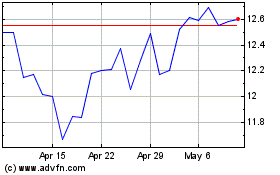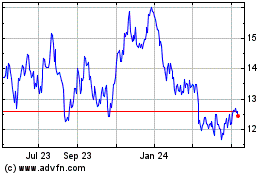By Benjamin Parkin and Paul Kiernan
BARÃO DE COCAIS, Brazil -- When Brazilian mining behemoth Vale
SA closed an iron-ore mine here earlier this year, it turned this
working-class town into a case study for a region whose traditional
industry is starting to slip away.
For centuries mining has been the lifeblood of communities
across Brazil's southeastern state of Minas Gerais, home to
colonial towns with baroque churches and ornate mansions built with
mineral wealth. Even today, Minas Gerais remains one of Brazil's
more prosperous states, thanks in large part to the jobs and
royalties generated by companies like Vale.
But a hollowing-out has begun, and concerns are growing that
this region could one day resemble the U.S. Rust Belt or
Appalachian coal country.
A thousand miles north, meanwhile, in the Carajás mountains of
the Amazon rain forest, Vale is putting the finishing touches on a
$14-billion mining complex known as S11D. Set to ramp up in the
coming months, it will crank out as much as 90 million tons a year
of the highest-quality, lowest-cost iron ore in the world. By 2018,
half of Vale's production is expected to come from Carajás, up from
39% extracted last year from its existing mines in the region.
That shift is beginning to be felt in towns like Barão de
Cocais, where the closure of Vale's Gongo Soco iron-ore mine in
April caused royalty payments to virtually dry up. Unemployment is
rising, shuttered houses and businesses line the streets and
municipal revenue is projected to fall by around one-fourth next
year.
"Mining finishes eventually," said mayor-elect Décio dos Santos,
adding that the town is ill-prepared for life without Vale. "We
need to think about more sustainable forms of development."
Decades of intensive mining have left Minas Gerais with depleted
deposits that are increasingly costly and less feasible to exploit,
with iron-ore prices crashing from nearly $200 a ton in 2011 to
below $40 earlier this year. Prices have since recovered somewhat
to around $80 currently.
Refining this lower-grade ore also produces large volumes of
waste that can be dangerous to store. After a dam failure at Vale's
Samarco joint venture in nearby Mariana last year killed 19 people,
company executives and local politicians say regulators have balked
at granting the licenses Vale would need to mine fresh deposits in
the region.
"The future here is not certain," said Karina Rapucci,
co-manager of Vale's nearby Brucutu iron-ore mine, the largest in
Minas Gerais.
As a result, Vale has increasingly focused its investments on
vast, untapped reserves in Carajás, where the ore is so rich it
generates little waste and is cheap enough to be profitable in
virtually any price scenario. Vale sees S11D bringing lower upkeep
costs and higher margins, ferrous minerals director Peter Poppinga
said in November. The new mine should enable the company to easily
offset depletion in its older pits, he added.
That bodes ill for Minas Gerais, where mining is still the
mainstay of many communities that have done little to diversify
their economies. Citing dwindling mining activity, Governor
Fernando Pimentel recently declared "financial calamity" as the
state struggles to maintain public services and pay salaries.
In Barão de Cocais, a town of around 30,000, royalty-fueled
building sprees spawned new government offices and public-sector
jobs. But without Gongo Soco to prop up the budget, Mr. dos Santos,
the incoming mayor, plans to lay people off and cut municipal
agencies next year, while potholed streets go unrepaired.
Unemployed miners like Júlio César dos Reis fear for the future.
Suffering from rare Graves' Eye Disease, he now no longer has the
health insurance to get the surgeries he needs.
"How am I going to find work...without treatment?" Mr. dos Reis
said.
A 40-minute drive east of Barão de Cocais, the town of São
Gonçalo do Rio Abaixo finds itself in a similarly vulnerable
spot.
Once a rural outpost where residents scraped by harvesting
bananas and sugar cane, the town was transformed almost overnight
in 2006 when Vale opened its Brucutu mine. Per capita gross
domestic product soared to more than $100,000 in 2014, on par with
San José in California's Silicon Valley. The unprecedented flood of
wealth spawned a new fleet of cars for city hall, a handsome
stadium and a gourmet burger joint.
But despite having fewer than 11,000 inhabitants, the local
government also increased its payroll almost 700% to 1,600 over the
past decade, highlighting a common practice in commodity-dependent
parts of Brazil.
Vale has already dug out the most of best ore from the Brucutu
sections within São Gonçalo's borders, meaning a likely decline in
the royalties to which the city has grown accustomed.
São Gonçalo's mining wealth came -- and is poised to fade -- so
quickly that it never touched some residents. Development
indicators like literacy and child-mortality rates lag behind
Brazilian averages. with 10% of the town's residents burning their
garbage at home. Scenes of crushing poverty are still to be found
along the dirt tracks leading off the town center's freshly
asphalted roads.
Conceição Moreira Duarte gets by on subsistence level with her
son and husband in the nearby woodland, surviving on government
benefits and her husband's sporadic salary as a day laborer.
"For us here, nothing has changed," she said.
(END) Dow Jones Newswires
December 19, 2016 05:44 ET (10:44 GMT)
Copyright (c) 2016 Dow Jones & Company, Inc.
Vale (NYSE:VALE)
Historical Stock Chart
From Mar 2024 to Apr 2024

Vale (NYSE:VALE)
Historical Stock Chart
From Apr 2023 to Apr 2024
